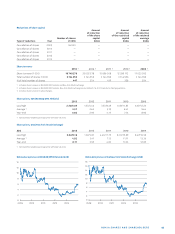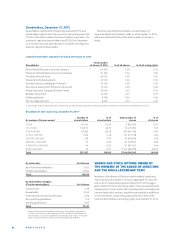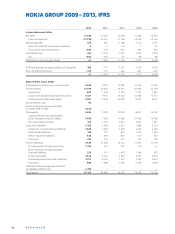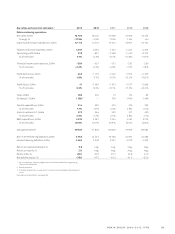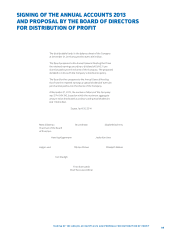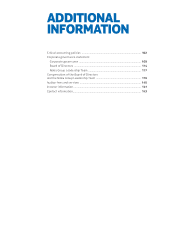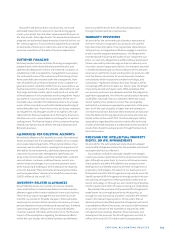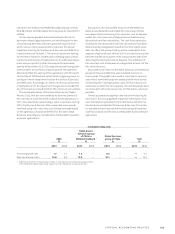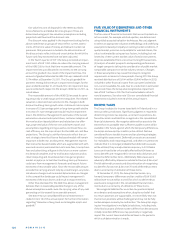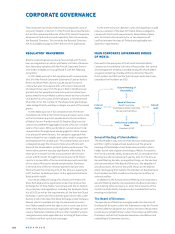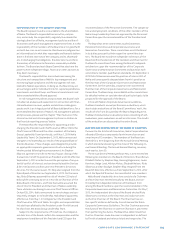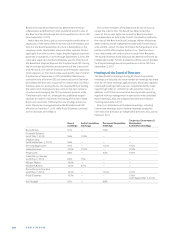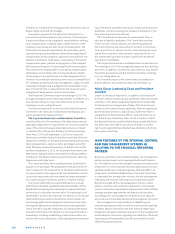Nokia 2013 Annual Report Download - page 104
Download and view the complete annual report
Please find page 104 of the 2013 Nokia annual report below. You can navigate through the pages in the report by either clicking on the pages listed below, or by using the keyword search tool below to find specific information within the annual report.NOKIA IN 2013
102
CRITICAL ACCOUNTING POLICIES
Our accounting policies aff ecting our fi nancial condition and
results of operations are more fully described in Note to our
consolidated fi nancial statements included in Item of this
annual report. Some of our accounting policies require the
application of judgment by management in selecting appropri-
ate assumptions for calculating fi nancial estimates, which
inherently contain some degree of uncertainty. Management
bases its estimates on historical experience and various other
assumptions that are believed to be reasonable under the
circumstances. The related results form the basis for making
judgments about reported carrying values of assets and li-
abilities and reported amounts of revenues and expenses that
may not be readily apparent from other sources. The Group
will revise material estimates if changes occur in the circum-
stances on which an estimate was based or as a result of new
information or more experience. Actual results may diff er from
current estimates under diff erent assumptions or conditions.
The estimates aff ect all our businesses equally unless other-
wise indicated.
The following paragraphs discuss critical accounting policies
and related judgments and estimates used in the preparation
of our consolidated fi nancial statements. We have discussed
the application of these critical accounting estimates with our
Board of Directors and Audit Committee.
REVENUE RECOGNITION
Revenues within the Group are generally recognized when the
signifi cant risks and rewards of ownership have transferred to
the buyer, continuing managerial involvement usually associ-
ated with ownership and eff ective control have ceased, the
amount of revenue can be measured reliably, it is probable that
economic benefi ts associated with the transaction will fl ow to
the Group and the costs incurred or to be incurred in respect
of the transaction can be measured reliably. When manage-
ment determines that such criteria have been met, revenue is
recognized.
At NSN, transactions are also entered into involving multi-
ple components consisting of any combination of hardware,
services and software. Within these arrangements, separate
components are identifi ed and accounted for based on the
nature and fair value of those components and considering
the economic substance of the entire arrangement. Revenue
is allocated to each separately identifi able component based
on the relative fair value of each component. The fair value of
each component is determined by taking into consideration
factors such as the price of the component when sold sepa-
rately and the component cost plus a reasonable margin when
price references are not available. This determination of the
fair value and allocation thereof to each separately identifi able
component of a transaction requires the use of estimates and
judgment which may have a signifi cant impact on the timing
and amount of revenue recognized for the period. Service rev-
enue, which typically includes managed services and mainte-
nance services, is generally recognized on a straight-line basis
over the specifi ed period unless there is evidence that some
other method better represents the rendering of services.
Also at NSN, certain revenue is recognized from contracts
involving solutions achieved through the modifi cation of
complex telecommunications equipment on the percentage
of completion basis when the outcome of the contract can be
estimated reliably. Recognized revenues and profi t estimates
are subject to revisions during the project in the event that
the assumptions regarding the overall project outcome are
revised. Current sales and profi t estimates for projects may
materially change due to the early stage of a long-term pro-
ject, new technology, changes in the project scope, changes in
costs, changes in timing, changes in customers’ plans, realiza-
tion of penalties, and other corresponding factors.
Within the HERE business, a substantial majority of revenue
is derived from the licensing of the HERE database. Revenue
which consists of license fees from usage (including license
fees in excess of the nonrefundable minimum fees), are rec-
ognized in the period in which the license fees are estimable.
Nonrefundable minimum annual licensing fees are generally
received upfront and represent a minimum guarantee of fees
to be received from the licensee during the period of the
arrangement. The total up-front fee paid by the customer
is generally amortized ratably over the term of the arrange-
ment. When it is determined that the actual amount of licens-
ing fees earned exceeds the cumulative revenue recognized
under the amortization method, we recognize the additional
licensing revenue. Furthermore, within the HERE business,
some licensing arrangements contain multiple elements, that
could include data, software, services and updates. Revenue is
allocated to each element based on its relative fair value and
is recognized as the element is delivered and the obligation is
fulfi lled.
Advance Technologies’ patent license agreements are multi-
year arrangements usually covering both a licensee’s past
and future sales until a certain agreed date, when the license
expires. Typically, when a patent license agreement is signed
it includes an agreement or settlement on past royalties that
the licensor is entitled to. Such income for past periods is
recognized immediately. The license payments relating to the
future royalties are recognized over the remaining contract
period, typically to years. Licensees often pay a fi xed
license fee in one or more installments and running royalties
based on their sales of licensed products. Licensees gener-
ally report and pay their running royalties on a quarterly basis
after the end of each quarter and Nokia revenue recognition
takes place accordingly at the time the royalty reports are
received.
Within Devices & Services, the sale of devices can include
multiple components consisting of a combination of hardware,
services and software. The commercial eff ect of each sepa-
rately identifi able element of the transaction is evaluated in
order to determine the appropriate accounting treatment for
each component of the transaction. The total amount re-
ceived is allocated to individual components based on their es-
timated fair value. Fair value of each component is determined
by taking into consideration factors such as the price when the
component is sold separately, the price when a similar compo-
nent is sold separately by a third party and cost plus a reason-
able margin when pricing references are not available. The es-
timated fair values are allocated fi rst to software and services,
with the residual amount allocated to hardware. Application
of the recognition criteria described above generally results in
recognition of hardware related revenue at the time of deliv-
ery with software and services related revenue recognized on
a straight-line basis over their respective terms.



